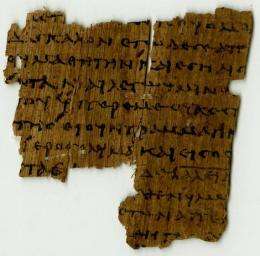Research grant combines astrophysics and archeology to decipher ancient texts

Lucy Fortson, an astrophysicist and Associate Professor in the College of Science and Engineering at the University of Minnesota is part of a collaboration called Ancientlives which has received a grant to apply the analysis tools of astrophysics to help decipher a collection of ancient Egyptian papyri.
Co-PIs Nita Krevans and Philip Sellew, faculty members in Classical and Near Eastern Studies, will be working with Professor Fortson and an international team, including a new University of Minnesota post-doctoral fellow in papyrology, to oversee citizen transcribers who will volunteer to identify letters on these ancient scraps of books and documents.
The collection known as the Oxyrynchus Papyri was discovered over a hundred years ago yet archeologists and classics scholars have only managed to transcribe a handful of these fragments. Fortson said the papyri came from an ancient garbage dump and mundane documents such as insurance claims and contracts were mixed in with Homer and works by the ancient playwright Menander. Classics scholars originally had to rely on their personal knowledge of ancient texts in order to determine the meaning of the texts and thus far only 15% of the collection has been edited. The hope is that Ancient Lives will help complete the editing process by harnessing the brain-power of volunteers—no knowledge of ancient Greek required.
As classical works enter databases it has become possible to search for strings of words, but archeologists have been unable to contend with the sheer volume of the papyri and the variations in handwriting between various scribes as well as the fact that 90% of the texts are non-literary (i.e. unique texts not entered into a literary database). This is where Zooniverse, a collaboration of astrophysicists and public volunteers comes in. The general public will be able to help “read” the texts by locating the placement of ancient Greek letters, and matching the shapes of letters in order to help create strings of letters, which will allow the algorithms to learn to translate and recognize the various characters. Using an interface first developed for the Zooniverse collaboration to allow the general public to identify the shapes of galaxies, volunteers will be able to click on places where they think a letter might be. This data should train the algorithms to improve their ability to translate the texts.
Professor Fortson is Principal Investigator of the grant entitled, “The Data Deluge: Applying Data Processing Techniques Derived from Astrophysics Citizen Science Projects to Research Problems in Egyptian Papyrology.” The grant is for the amount of $249,829. The grant will be used to hire a papyrologist to work on the project in the Classical and Near Eastern Studies Department.
More information: More information at www.ancientlives.org
Provided by University of Minnesota


















